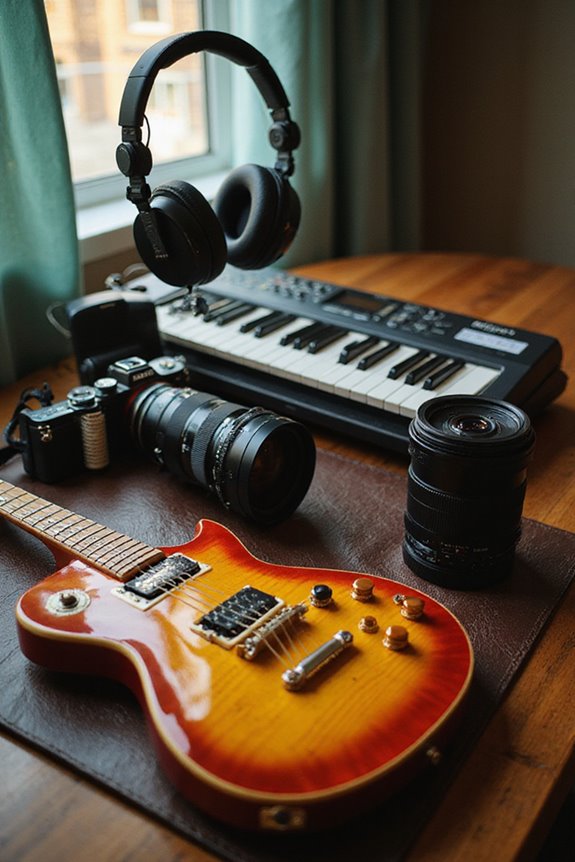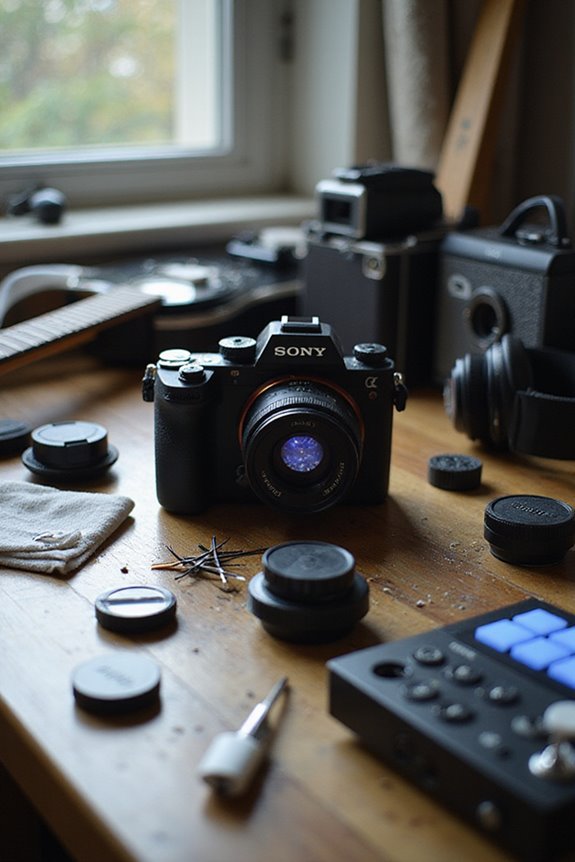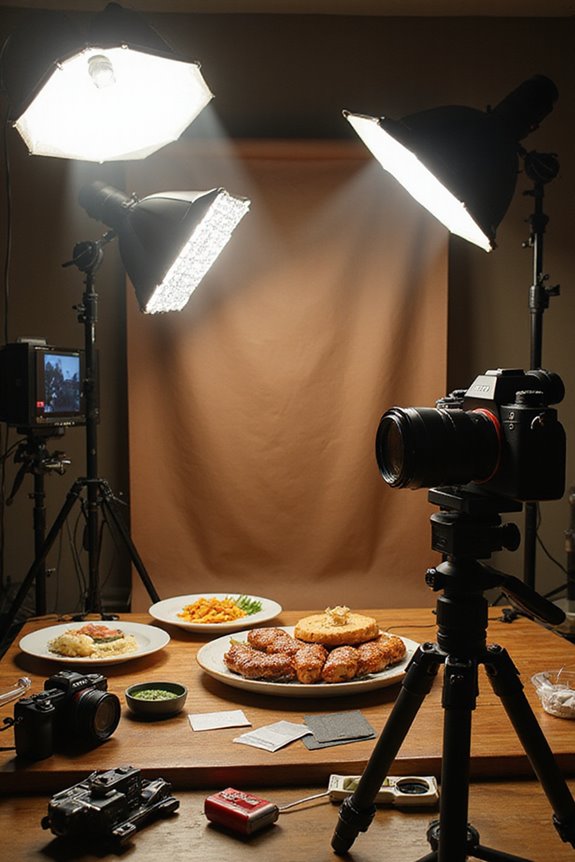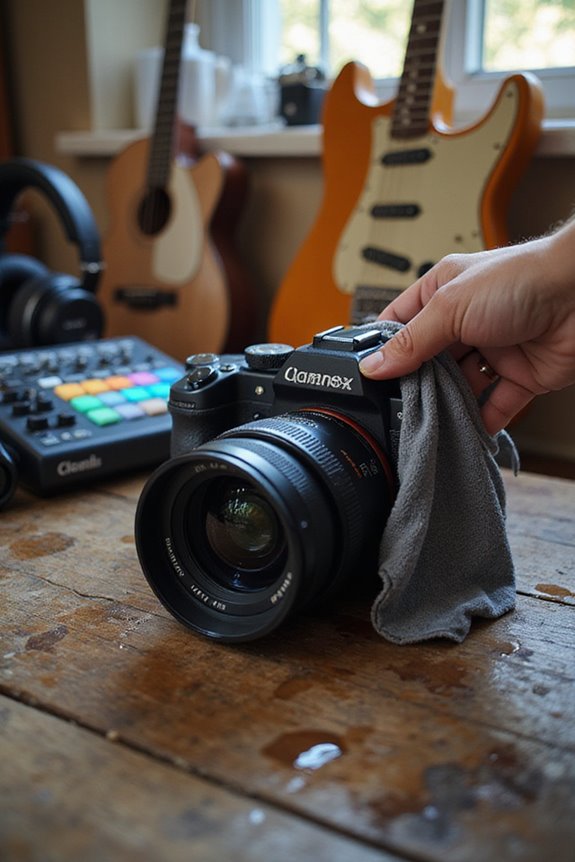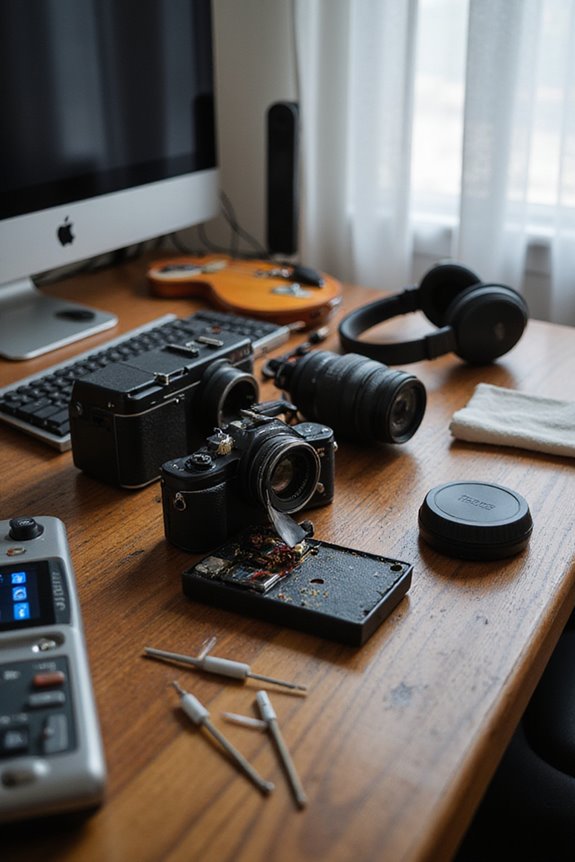In fashion photography, we need to take into account several key camera requirements to achieve stunning results. Opt for mirrorless models like the Sony Alpha a7R III or medium format options such as the Hasselblad H5D-50 for superior image quality. A versatile 24-70mm lens or an 85mm prime lens works wonders for various compositions. Don’t forget reliable power sources and high-speed storage to keep up with dynamic shoots. If we continue, we’ll explore essential accessories and advanced technology transforming fashion photography.
Key Takeaways
- Choose a camera with a high-resolution sensor, like the Sony Alpha a7R III, for capturing intricate details in fashion photography.
- Select versatile lenses, such as a 24-70mm zoom or an 85mm prime, to enhance composition and portrait quality.
- Invest in high-capacity batteries and fast memory cards to ensure uninterrupted shooting during long sessions.
- Utilize portable lighting equipment, including battery-powered strobes and LED panels, for effective illumination in various environments.
- Regularly maintain and protect your camera gear to ensure reliability and longevity during fashion shoots.
Camera Types and Specifications
When it comes to fashion photography, choosing the right camera type and specifications can make all the difference in capturing stunning images. In our camera comparison, we see that mirrorless options like the Sony Alpha a7R III excel with a 42.4 MP full-frame sensor, offering impressive sensor performance for detailed shots. Its compact design enhances portability, making it ideal for dynamic runway moments. On the other hand, the Canon EOS 5D Mark III balances resolution and usability, featuring a 30.4 MP sensor that’s reliable for long shoots. For high-end work, medium format cameras like the Hasselblad H5D-50 provide exceptional sharpness and color fidelity, perfect for capturing the rich textures of fashion. Selecting the right camera truly elevates our photography game. Additionally, understanding the importance of sensor size impact can significantly influence the creative results you achieve.
Essential Lens Selection
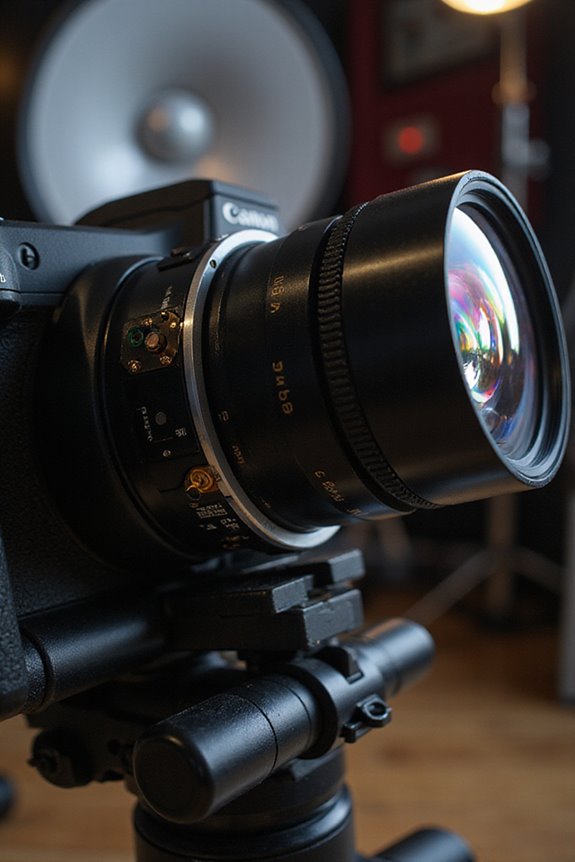
Selecting the right lens can greatly enhance our fashion photography, as each type offers unique advantages tailored to different shooting scenarios. For versatile lens options, the 24-70mm zoom lens stands out, providing us with lens versatility and the ability to capture various compositions from a fixed position. It also supports creative distortion, allowing for engaging angles that emphasize our subjects.
For portraits, we’d appreciate an 85mm prime lens for its sharpness and beautiful background separation, ideal for half-body shots. Meanwhile, a 35mm lens is perfect for full-body portraits and environmental storytelling. Ultimately, the 70-200mm zoom lens excels in capturing details from a distance, making it invaluable for editorial work. Each option helps us tell compelling fashion stories effectively. Additionally, understanding lens compatibility factors ensures that we can select the best lenses that work seamlessly with our camera systems.
Power and Storage Essentials
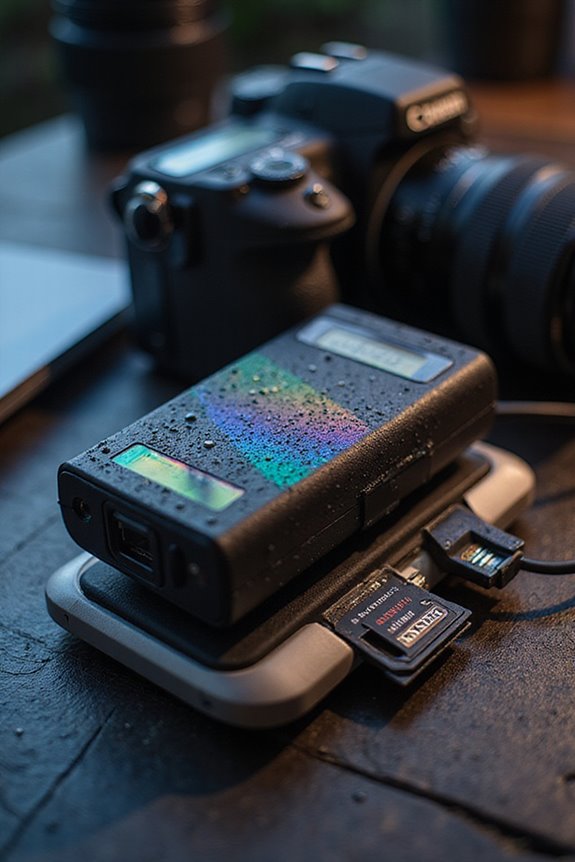
In the fast-paced world of fashion photography, having reliable power and storage solutions is essential for uninterrupted creativity. We need to prioritize battery management, especially with DSLR and mirrorless cameras that can consume significant power, particularly during continuous shooting or video recording. High-capacity lithium-ion batteries and quick-swapping options help us maintain efficiency on location.
For storage, using high-speed UHS-II SD cards or CFexpress cards guarantees we can handle high-resolution images without lag. Incorporating data redundancy through multiple cards offers peace of mind against data loss. Additionally, planning for power optimization with portable battery packs guarantees our shoots run smoothly, keeping our focus on creativity rather than technical issues. High-speed memory cards with UHS Class 3 ratings ensure optimal write speeds, making them ideal for capturing rapid bursts of images in dynamic fashion shoots.
Additional Equipment for Lighting and Control
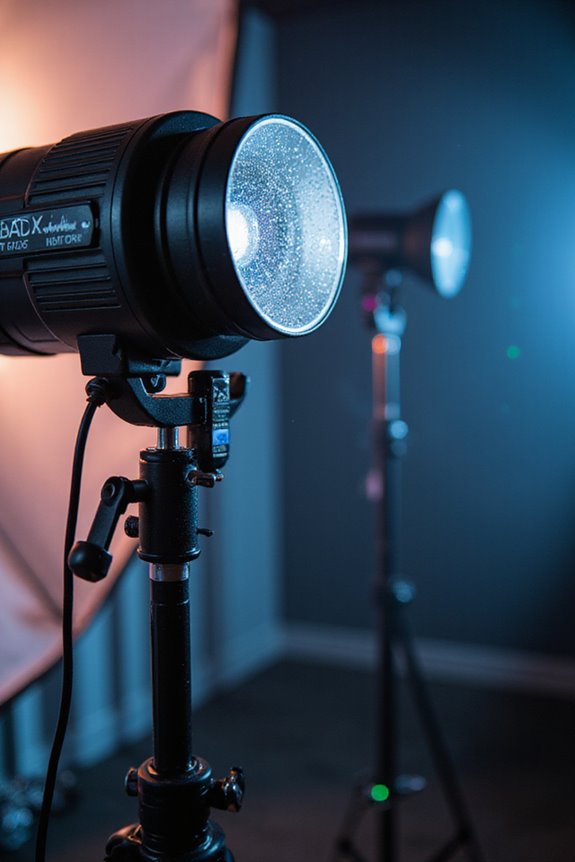
To elevate our fashion photography, incorporating additional equipment for lighting and control becomes essential. High-quality reflectors allow us to bounce and direct light, enhancing our subjects beautifully. Flags help shape that light, creating shadows or reducing unwanted spills—perfect for both studio and natural settings.
Using light modifiers like softboxes and umbrellas softens harsh light, giving our portraits a flattering appearance. Battery-powered strobes provide portability and powerful bursts, ideal for location shoots. Meanwhile, LED panels offer continuous lighting, allowing us to experiment with various lighting techniques. By leveraging these tools, we can achieve stunning results that elevate our fashion imagery and meet diverse creative needs. Additionally, considering the variety of lighting types in our setups ensures we can adapt to different photography styles effectively.
Support and Accessories
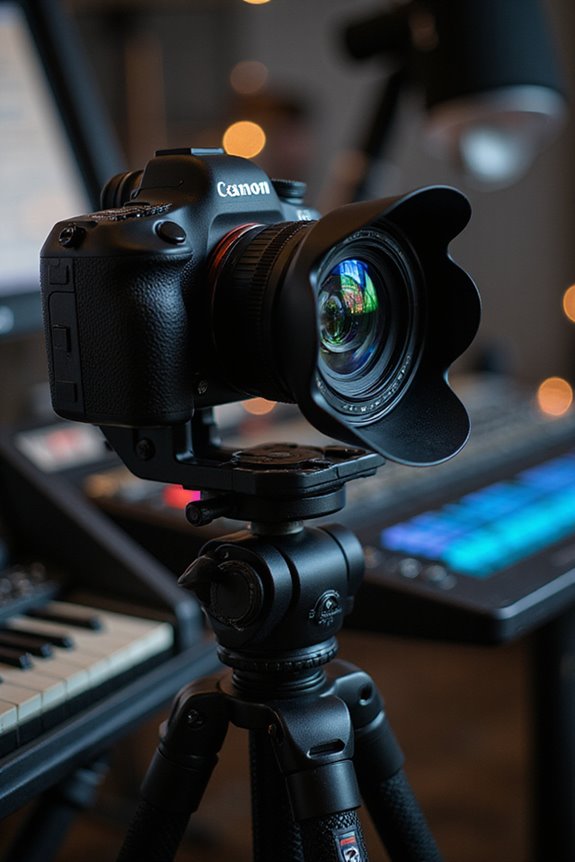
Having the right support and accessories can make a world of difference in fashion photography. For instance, using carbon fiber tripods guarantees tripod stability while being lightweight and durable, perfect for our on-the-move shoots. Motorized stands offer full remote control over camera adjustments, letting us optimize compositions without needing to reposition physically. Ergonomic designs in operator stands enhance our comfort during long sessions, allowing us to maintain good posture and workflow efficiency. Quick-release plates speed up camera attachment, vital for dynamic environments. Additionally, shoulder mounts and gimbals facilitate smooth, handheld shots, while lens support systems help reduce strain on our equipment. With these tools, we can focus more on creativity and less on technical challenges. Choosing a tripod with higher weight capacity ensures that it can support heavier camera setups, providing added stability for our fashion shoots.
Professional Quality Considerations
When it comes to fashion photography, achieving professional quality is paramount for showcasing garments and styles effectively. We recognize that high image resolution is essential, allowing us to capture intricate details and textures that elevate our work. Utilizing medium format sensors can deliver superior resolution, while mirrorless cameras with advanced sensor performance provide excellent dynamic range and color accuracy.
Additionally, we can’t overlook autofocus accuracy. Fast and precise autofocus systems guarantee sharp focus on moving models, particularly during dynamic shoots. Features like eye and face detection enhance our ability to maintain focus on the model’s features, making our images truly pop. Ultimately, these elements contribute considerably to the overall quality of our fashion photography, helping us create stunning visuals that resonate with audiences. Incorporating a camera with advanced autofocus systems can significantly improve our ability to capture the perfect shot in fast-paced environments.
Choosing the Right Camera for Fashion Photography
While the array of camera options can feel overwhelming, selecting the right one for fashion photography doesn’t have to be an intimidating task. We should prioritize sensor performance, as full-frame sensors provide sharp detail to capture clothing textures beautifully. Cameras like the Nikon Z8 or Leica Q3, with their high megapixels, excel in this regard. Additionally, we can’t overlook autofocus systems; advanced options like Canon’s 1D X Mark III guarantee we keep fast-moving models in focus. Continuous shooting speeds of 7-20 fps are essential for capturing dynamic moments. Finally, consider the camera’s size and weight—lighter models like the Fujifilm X-T4 enhance our mobility during location shoots, making our workflow smoother and more efficient. Implementing 5-axis image stabilization can also greatly improve the quality of images captured in challenging conditions.
Tips for Maintaining Your Camera Gear
Maintaining our camera gear is just as important as choosing the right equipment for fashion photography. We should regularly use cleaning techniques, like a blower or air puffer, to keep dust off our lenses and camera bodies. Wiping down the camera daily helps remove sweat and sunblock that can cause damage.
For gear organization, storing our equipment in a dehumidified cabinet prevents grime buildup, especially in damp areas. When changing lenses, we should do so in clean environments and handle everything with clean hands. Additionally, using protective accessories like lens hoods and camera skins can shield our gear from scratches and impacts. Regular check-ups and professional servicing will guarantee our gear remains reliable and functional for every shoot. Furthermore, using microfiber cloths for gentle surface cleaning can enhance the clarity and brightness of our images.
Advancements in Fashion Photography Technology
As we embrace the latest advancements in fashion photography technology, it’s clear that innovation is reshaping our creative processes and elevating the quality of our work. AI enhancements are revolutionizing our workflows, enabling faster, high-quality image production. Virtual models and immersive experiences allow for diverse representation, catering to a wider audience. With tools like Photoshop AI and Luminar Neo, advanced editing has become more efficient, freeing us from tedious tasks while maintaining authenticity in storytelling. We can explore emerging visual trends, from bold colors to hyper-realistic portraits, using drone photography for unique perspectives. These advancements not only enhance our creativity but also guarantee our work resonates with today’s diverse consumers.
Frequently Asked Questions
What Is the Ideal Camera Brand for Fashion Photography?
When considering the ideal camera brand for fashion photography, we find Nikon’s advantages in high resolution and color depth compelling, while Canon’s versatility with autofocus and lens options makes it a strong contender too.
How Does Weather Affect Outdoor Fashion Shoots?
Did you know that 60% of outdoor fashion shoots are impacted by weather conditions? We’ve learned to make light adjustments for seasonal trends while overcoming outdoor challenges to create stunning images that resonate with our audience.
What Settings Are Best for Shooting in Natural Light?
When we shoot in natural light, we should prioritize exposure settings like low ISO, wide apertures, and fast shutter speeds. This helps us achieve beautiful images with soft backgrounds and accurate colors.
How Can I Improve My Fashion Photography Skills?
To improve our fashion photography skills, we should focus on mastering composition techniques and experimenting with various lighting effects. By refining these areas, we’ll enhance our storytelling and create enchanting images that resonate with audiences.
What Are Common Mistakes to Avoid in Fashion Photography?
When we think about common mistakes in fashion photography, we should focus on composition techniques, lighting challenges, model expressions, location scouting, wardrobe choices, and post-processing tips to guarantee our images truly shine.

